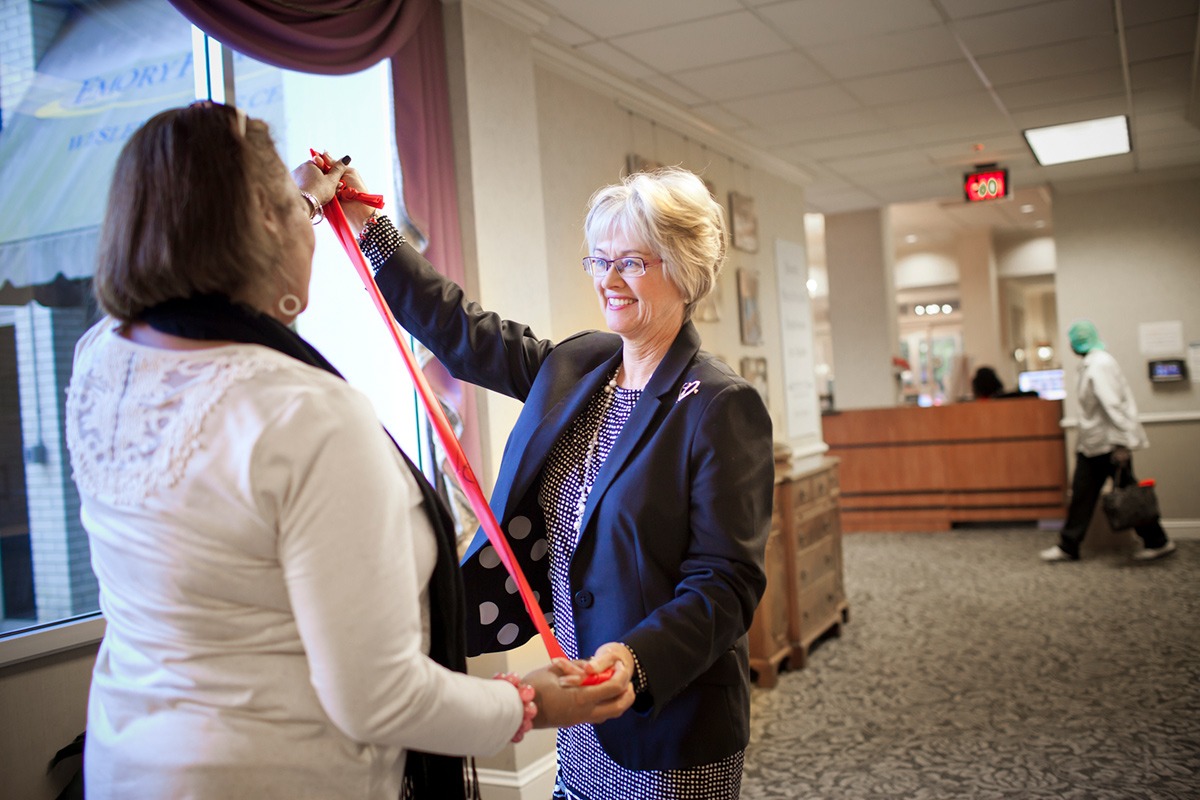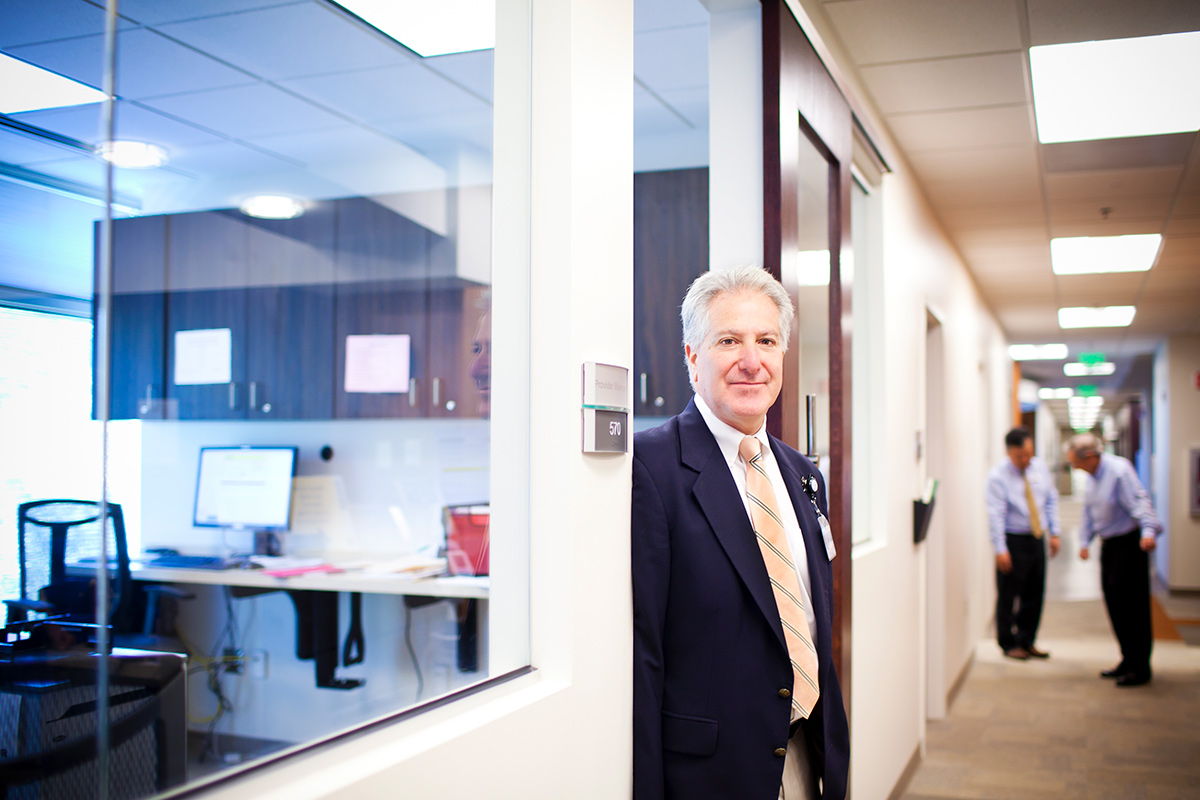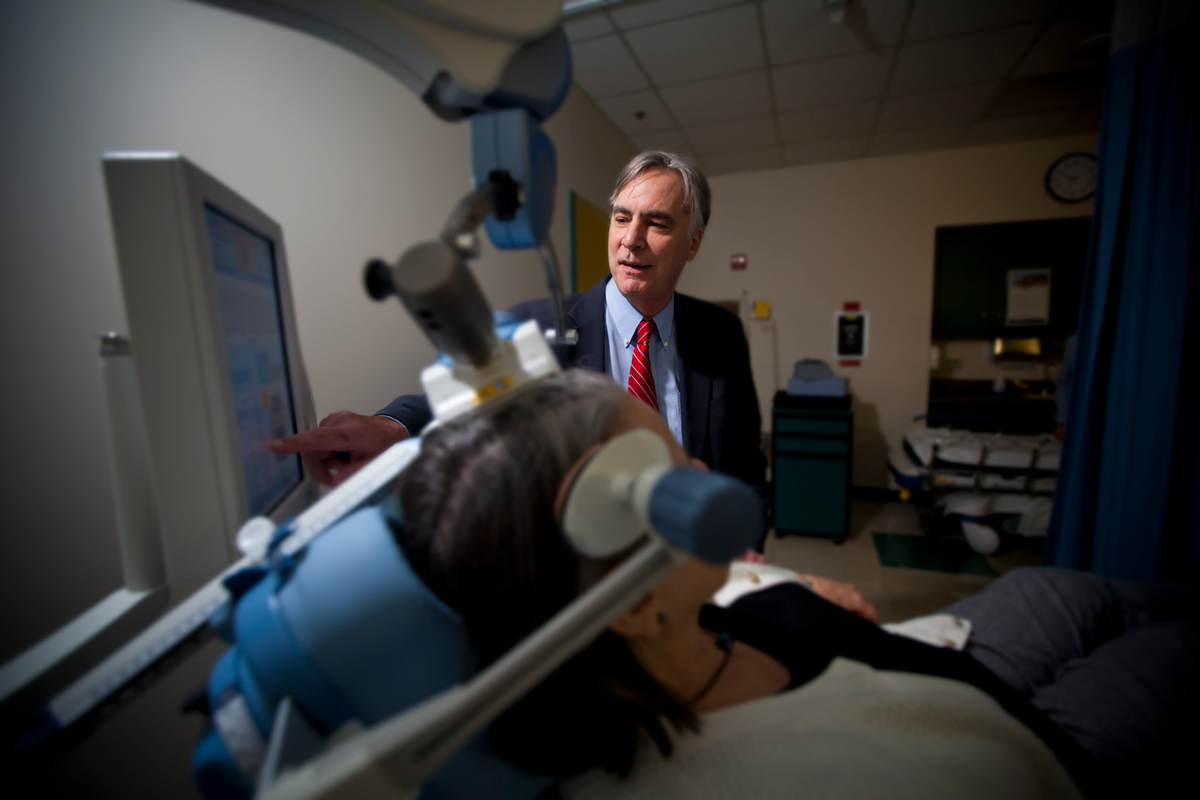Keeping Time
As lives get longer, Emory researchers seek ways to make them better

Photos by Kay Hinton
"She cooks all the meals, does my laundry, takes me to get my hair done, gets my prescriptions picked up.” Susie Spezia is ticking off the things her daughter, Melissa Faulkner, does for her. Soft-spoken and petite, Spezia has shared her daughter’s Atlanta home for the past two years. She is ninety-four years old.
Family caregivers have been around for as long as families have been around. At Emory, their service is the subject of research designed to learn new tools for performing these roles better while mitigating the sometimes enormous stress that comes with providing informal care for an elderly relative. It’s but one aspect of a broad range of collaborative research activities at Emory designed to address the multitude of issues surrounding aging and health.
Spezia spends her days reading, working word puzzles, and, in season, watching baseball. She is in remarkably good health, which makes Faulkner’s job easier. “A lot of individuals have no choice but to be in an institutionalized setting,” Faulkner says. “People like my mother, who are still self-sufficient enough to bathe and feed themselves, don’t need all those services that a traditional nursing home provides.”
Spezia is diabetic, which increases her risk for heart failure, and she’s unsteady on her feet. There’s some numbness in her fingers, the result of nerve damage from diabetes. She exercises daily by walking a route around the home’s first floor. Steps present a major obstacle. The residence has a second story that she, with much patience and helping hands, has visited just once, out of curiosity. “I haven’t been back again,” she says plainly.
Faulkner takes her mom to medical appointments at the Wesley Woods Outpatient Clinic and to the Emory Eye Clinic for treatment of macular degeneration. It’s familiar territory for Faulkner, who serves on the Emory faculty as a professor in the School of Nursing.
It’s also not the first time Faulkner has found herself in a caregiving situation. As a nurse, she has cared for other people’s family members, and she helped take care of her husband twenty years ago as he battled cancer. Her experience and education lend a skill advantage to her latest caregiving role, but the motivation comes from somewhere else: “You do it out of love for your family member.”
Caring for the caregivers
“If you haven’t already had a caregiving experience as an adult, it’s highly likely that you have one coming,” says Sandra Dunbar, Charles Howard Candler Professor of Cardiovascular Nursing and associate dean for academic advancement.
A specialist in cardiovascular disease, she became interested in the role of family caregiving when she noted a relationship between the quality of family care and the ability of cardiac patients to cope with and manage their disease.
“I realized that I can improve patient outcomes if I can improve support to family caregivers,” she says. “So I started looking at what family caregivers need not just in terms of understanding their caregiving role, but how to take care of themselves as caregivers.”
Previous studies had focused on the needs of caregivers of stroke, cancer, and dementia patients, but little had been done to examine the needs of those caring for patients with heart failure.
Dunbar notes that, compared to non-caregiving individuals of the same age, family caregivers of individuals with heart failure exhibit a higher-than-average mortality rate, are prone to symptoms of premature aging, exhibit symptoms of depression, and experience increased stress levels, thus an increased risk for cardiovascular problems of their own. These risks are amplified when the caregiver is getting along in years, too; it’s not uncommon for people approaching retirement age to find themselves caring for a parent in their eighties or nineties.
“Learning more about what family caregivers need is one of the first steps,” says Dunbar. “Then we’re trying to devise systems and approaches that will support the family—that’s what our work is about.”
Near the top of the list is a need for care-givers to carve out personal time. Faulkner agrees. “There are times when my husband and I need a little break, and we’ll go out to dinner by ourselves.”
Exercise is another important activity that caregivers should work into their schedules. “We’ve created a program to help them identify barriers and find ways to incorporate exercise into their weekly routines,” Dunbar explains. “Physical activity has a lot of positive benefits in terms of reducing cardiovascular risk, helping the family caregiver sleep better, and also improving their own functional status.”
Dunbar’s research also has led to a program that teaches caregivers ways to help their patients feel more autonomous by giving them choices in everyday matters, allowing them a sense of control while still providing support.
“We talk about the burden or the strain of caregiving,” Dunbar continues, “but it can also be enormously satisfying and bring a sense of joy and satisfaction. Helping people focus on those positive aspects is really important, too.”

The Time Will Come: Through research and practical programs, Sandra Dunbar supports those who are caring for an elderly family member—a situation that she says most of us will experience at some point.
There’s no place like home
No one has ever said, “I can’t wait to get into a nursing home.” Yet, for many years, it was the default option when elderly people showed the first signs of being unable to care for themselves. For those who require a high level of nursing care and medical supervision, a nursing home or similar environment is often the most sensible course.
But a growing number of seniors are opting to “age in place”—whether at their home, a relative’s home, or a retirement community.
Researchers at Emory are exploring ways to adapt the home environment to accommodate the needs of elderly people so they can remain healthy enough to live as independently as possible for as long as possible.
At the Center for Health in Aging (CHA), researchers work with engineers and architects to develop innovative solutions that go beyond standard grab bars and ramps. According to Rebecca Dillard, assistant program director, “It might be something like a special kind of pressure-sensitive carpet or flooring that electronically tracks the movement of people with dementia or mobility impairment, allowing medical staff at a remote monitoring station to tell whether someone has fallen.”
CHA supports a major educational component as well, Dillard adds, that includes a course titled Healthy Aging in the Twenty-First Century. Developed by Dillard and Madeleine Hackney, assistant professor of medicine in the Department of Medicine, in response to numerous requests from community groups for guest speakers, the two-month course meets for ninety minutes weekly and is offered twice a year at no charge to senior groups throughout metro Atlanta. Classes are taught by Emory faculty and address topics ranging from self-management of chronic disease to proper diet and exercise.
Three years ago, a group of Emory medical students expanded on the idea to create Senior University. Classes addressing elder care and health are taught by the students twice a week over a twelve-week period. Dillard and Hackney serve as faculty advisers. Earlier this year, the National Parkinson Foundation provided a grant to produce a version of Senior University tailored to the health needs of Parkinson’s patients and their caregivers.
An innovative online service developed by Emory researchers provides online support and training for family caregivers of elderly patients with Alzheimer’s or other dementias. Called Tele-Savvy, the program features informative videos as well as regular one-on-one contact in real time between caregivers and medical experts at Emory through iPads and similar devices. Tele-Savvy, which has been widely copied in other states, is particularly useful for elderly people who live in rural areas and want to remain in their own homes.
Another program technically falls under the rubric of education and senior health, but its participants will tell you that it’s really just a great night out. Hackney, a professional ballroom dancer before she entered academia, had the idea that learning a specially designed tango might help older people with Parkinson’s disease improve their gait and balance. Tango is a partnered dance with a distinct rhythm that’s easy to learn. She created a series of “adapted tango” dance lessons that are offered free of charge at several locations in metro Atlanta. The lessons are open to older adults with mobility problems—including those who use walkers—as well as their family members and caregivers.
Participants also provide valuable data for Hackney’s ongoing research. She conducts various kinesioscopic measurements before and after the classes, and has found that adapted tango is just as effective if not more so than traditional exercises for improving gait and balance—and a lot more fun.
Tackling the ‘A’ word
As people age, their number-one health concern is a fear of losing their ability to think, reason, and remember. In a word, they worry about developing Alzheimer’s.
Allan Levey understands those concerns, and as director of the Emory Alzheimer’s Disease Research Center (ADRC), his goals are to characterize the disease’s pathology, discover ways to determine who is and who is not at risk, and develop therapies to prevent the disease.
Any kind of brain insult that causes permanent or progressive injury can lead to dementia: Parkinson’s disease, brain tumor, multiple sclerosis, stroke. But Alzheimer’s is by far the most common.
“Alzheimer’s disease is an age-related condition,” he says. “The older a person gets, the greater the chances are they will develop the disease. By the time someone reaches age eighty-five, the chances are nearly one in two that person will have Alzheimer’s disease.”
Like most forms of dementia, Alzheimer’s is progressive. It usually begins with memory loss, typically referred to in its early stages as mild cognitive impairment, but gradually affects higher intellectual abilities such as executive functioning, language, and visuospatial perception In the later stages of Alzheimer’s, people are unable to care for themselves and are completely dependent on others. They may forget how to walk or even how to recognize themselves in a mirror. They lose control of their bodily functions. They end up bedbound and susceptible to infection. Alzheimer’s is the sixth-leading cause of death by itself and the second-leading contributing cause of death.
In studies performed on individuals with the genetic mutation that virtually guarantees they will develop Alzheimer’s, brain imaging studies with PET have revealed a progressive accumulation of amyloids—proteins that accumulate around degenerating brain cells.
“Similarly, if we look at the spinal fluid that bathes the brain, we can see changes in amyloid and other biochemicals beginning about twenty years before the symptoms would start,” Levey notes.
That means that by the time a person begins showing clinical symptoms, the disease has already been building up in the brain for about two decades. “This tells us that we have a chance to prevent Alzheimer’s disease if we could detect it twenty years before symptoms begin,” Levey says.
But spinal taps are uncomfortable and time consuming, and PET scans cost thousands of dollars each. Plus, the technology is not readily accessible in many parts of the country. Levey is looking for an inexpensive, simpler alternative along the lines of a routine cholesterol screening or blood test that will allow doctors to quickly and accurately predict in whom and when the disease will begin.
Levey’s and the ADRC’s research is informed by the Healthy Aging Study, which involves a large number of volunteers whose brain health will be monitored over several years in an effort to identify predictive markers for dementia. The data will provide the foundation for testing disease-preventive medicines and help researchers distinguish between early Alzheimer’s symptoms and the early stages of other forms of dementia.
Even though the ADRC work is centered on Alzheimer’s, there will be progress along the way into other brain disorders, says Levey.
“We want to be able to distinguish Alzheimer’s disease from other causes of dementia so we can determine the specific changes associated with one type of dementia versus another. We have to understand the root cause of each of these conditions to be able to detect them, and to then intervene with the appropriate treatment.”

Advance Warning: Patients may show indications of Alzheimer's disease twenty years before they exhibit clinical symptoms. Allan Levey is exploring ways to detect the disease sooner so treatment can begin.
Searching for new therapies
Facing age-related ailments can have a compounding effect, influencing not only physical but mental health.
“There are a lot of secondary consequences to having depression when you’re older,” says William McDonald, J. B. Fuqua Chair for Late-Life Depression; chief, Division of Geriatric Psychiatry; and chief, Treatment Resistant Depression. “It affects your physical health. You tend to not take good care of yourself. You may stop eating or taking your medications, become inactive, not go to the doctor.”
Depression should not be considered a normal part of aging, McDonald cautions, noting that its incidence varies among different segments of the elderly population. Overall the frequency of depression in the general senior population ranges between 10 and 20 percent. Among Alzheimer’s and Parkinson’s patients, the numbers rise sharply.
“People need to recognize that depression is a very serious illness in older adults,” he says.
McDonald’s research specializes in neuromodulation therapies for elderly patients. Two widely used treatments are electroconvulsive shock therapy (ECT) and transcranial magnetic stimulation (TMS).
McDonald admits that ECT carries a stigma—unwarranted, in his view, because the procedure has been greatly refined over the past thirty years and bears no resemblance to its brutal portrayal in movies and television. ECT involves the delivery of small electric currents to the brain, producing changes in the brain chemistry that can quickly reverse symptoms of depression and certain other mental illnesses. The downside is that ECT may produce cognition problems. In addition, the technique is performed under a general anesthetic, which requires recovery time and carries a medical risk of its own.
“ECT can be a very effective treatment for older adults with depression who don’t respond to any other treatment,” says McDonald, noting its 80 percent remission rate. “For a lot of people, ECT is a life-saving treatment.”
McDonald was principal investigator in the development of TMS, another FDA-approved, widely used method for treating depression in older people who have not responded to medication. The technique involves a device placed on the patient’s head that stimulates the prefrontal cortex with electromagnetic impulses. The painless process takes about forty minutes, during which time the patient sits in a chair and can read or watch TV. Although not as effective as ECT, it does not require anesthesia and is less expensive and easier to perform.
Recently, McDonald wrapped up a study on transcranial direct-current stimulation, where an electromagnetic pulse is delivered to the brain to stimulate areas associated with depression. The technique has been used for years to treat Alzheimer’s and stroke patients, but not depression.
“If it works, it could be an easy, very safe advance that could be done in a clinic setting with relatively little oversight,” McDonald says. “Given that Emory is very much a leader in treatment-resistant depression, you want to be able to provide as many treatment options as possible.”

Keeping Spirits Up: Although it is common for elderly adults to become depressed, it should not be considered normal—nor should it go untreated, according to William McDonald, who is researching new treatments for late-life depression.
Healthy aging starts with youth
Emory’s Predictive Health Institute (PHI) advocates an approach that reverses the traditional medical paradigm’s reactive emphasis on diagnosing and treating disease, and instead embraces a proactive model emphasizing long-term, sustainable health. In other words, health is not simply the absence of disease; it’s a state of being with its own practices, measures, and attributes. It’s the product of a complex interplay of biological, social, and cultural factors. And it means that staying healthy during one’s senior years is contingent on maintaining health during the younger years.
“Our research is designed to help us better understand and characterize what it means to be healthy,” says Greg Martin, director of the PHI and the Center for Health Discovery and Well Being. “Once we understand this, we’ll be able to recognize deviations that lead to people becoming unhealthy.”
At the heart of the institute’s research efforts is an ongoing study of more than 750 individuals who submit to a battery of tests and examinations each year to ascertain their state of health over time. Participants also select health goals and are assigned a health partner, a member of the Emory staff, who serves as a resource, advocate, and counselor. Now in its seventh year, the study shares its extensive database with elder-health researchers and other scientists throughout the Emory medical community.
PHI’s holistic, long-term approach to maintaining health at all ages includes an education component: Emory undergraduates are required to take a course in predictive health, and a minor is also available.
“The course brings to students an understanding of health,” says Martin, “particularly how to maintain it over the continuum of their lives so that if they start early, as college students, it will make a difference when they’re seventy, eighty, ninety years old or more.”


